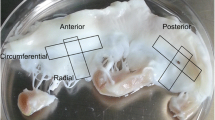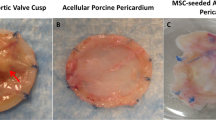Abstract
CD133mAb conjugation (CD133-C) hastens in vivo recellularization of decellularized porcine heart valve scaffolds when placed in the pulmonary position of sheep. We now characterize this early cellularization process 4 h, 3, 7, 14, 30, or 90 days post-implantation. Quantitative immunohistochemistry identified cell types as well as changes in cell markers and developmental cues. CD133+/CD31− cells adhered to the leaflet surface of CD133-C leaflets by 3 days and transitioned to native leaflet-like CD133−/CD31+ cells by 30 days. Leaflet interstitium became increasingly populated with both alpha-smooth muscle actin (αSMA) and vimentin+ cells from 14 to 90 days post-implantation. Wnt3a, and beta-catenin proteins were expressed at early (3–14 days) but not later (30–90 days) time points. In contrast, matrix metalloproteinase-2 and periostin proteins were increasingly expressed over 90 days. Thus, early development of CD133-C constructs includes a fairly rapid transition from a precursor cell adhesion/migration/transdifferentiation phenotype to a more mature cell/native valve-like matrix metabolism phenotype.






Similar content being viewed by others
References
Roger, V. L., Go, A. S., Lloyd-Jones, D. M., Adams, R. J., Berry, J. D., Brown, T. M., et al. (2011). Heart disease and stroke statistics—2011 update: a report from the American Heart Association. Circulation, 123, e18–e209.
Senthilnathan, V., Treasure, T., Grunkemeier, G., & Starr, A. (1999). Heart valves: which is the best choice? Cardiovascular Surgery, 7(4), 393–7.
Sacks, M. S., Enomoto, Y., Graybill, J. R., Merryman, W. D., Zeeshan, A., Yoganathan, A. P., Levy, R. J., Gorman, R. C., & Gorman, J. H., 3rd. (2006). In-vivo dynamic deformation of the mitral valve anterior leaflet. The Annals of Thoracic Surgery, 82(4), 1369–77.
Henaine, R., Roubertie, F., Vergnat, M., & Ninet, J. (2012). Valve replacement in children: a challenge for a whole life. Archives of Cardiovascular Diseases, 105(10), 517–28.
Schoen, F. J. (2011). Heart valve tissue engineering: quo vadis? Current Opinion in Biotechnology, 22(5), 698–705.
Mendelson, K., & Schoen, F. J. (2006). Heart valve tissue engineering: concepts, approaches, progress, and challenges. Annals of Biomedical Engineering, 34(12), 1799–819.
Rippel, R. A., Ghanbari, H., & Seifalian, A. M. (2012). Tissue-engineered heart valve: future of cardiac surgery. World Journal of Surgery, 36(7), 1581–91.
Butcher, J. T., & Nerem, R. M. (2006). Valvular endothelial cells regulate the phenotype of interstitial cells in co-culture: effects of steady shear stress. Tissue Engineering, 12, 905–915.
Butcher, J. T., Penrod, A. M., Garcia, A. J., & Nerem, R. M. (2004). Unique morphology and focal adhesion development of valvular endothelial cells in static and fluid flow environments. Arteriosclerosis, Thrombosis, and Vascular Biology, 24, 1429–34.
Niessen, K., & Karsan, A. (2008). Notch signaling in cardiac development. Circulation Research, 102, 1169–81.
Combs, M. D., & Yutzey, K. E. (2009). Heart valve development: regulatory networks in development and disease. Circulation Research, 105, 408–21.
Lee, D. J., Steen, J., Jordan, J. E., Kincaid, E. H., Kon, N. D., Atala, A., Berry, J., & Yoo, J. J. (2009). Endothelialization of heart valve matrix using a computer-assisted pulsatile bioreactor. Tissue Engineering. Part A, 15(4), 807–14.
Paruchuri, S., Yang, J. H., Aikawa, E., Melero-Martin, J. M., Khan, Z. A., Loukogeorgakis, S., Schoen, F. J., & Bischoff, J. (2006). Human pulmonary valve progenitor cells exhibit endothelial/mesenchymal plasticity in response to vascular endothelial growth factor-a and transforming growth factor-beta2. Circulation Research, 99(8), 861–9.
Brand, N. J., Roy, A., Hoare, G., Chester, A., & Yacoub, M. H. (2006). Cultured interstitial cells from human heart valves express both specific skeletal muscle and non-muscle markers. The International Journal of Biochemistry & Cell Biology, 38(1), 30–42.
Mulholland, D. L., & Gotlieb, A. I. (1996). Cell biology of the valvular interstitial cells. The Canadian Journal of Cardiology, 12, 231–6.
Dreger, S. A., Taylor, P. M., Allen, S. P., & Yacoub, M. H. (2002). Profile and localization of matrix metalloproteinases (MMPs) and their tissue inhibitors (TIMPs) in human heart valves. The Journal of Heart Valve Disease, 11, 875–80.
Rabkin-Aikawa, E., Farber, M., Aikawa, M., & Schoen, F. J. (2004). Dynamic and reversible changes of interstitial cell phenotype during remodeling of cardiac valves. The Journal of Heart Valve Disease, 13(5), 841–7.
Rabkin-Aikawa, E., Mayer, J. E., Jr., & Schoen, F. J. (2005). Heart valve regeneration. Advances in Biochemical Engineering/Biotechnology, 94, 141–79. Review.
Alfieri, C. M., Cheek, J., Chakraborty, S., & Yutzey, K. E. (2010). Wnt signaling in heart valve development and osteogenic gene induction. Developmental Biology, 338(2), 127–35.
Jordan, J. E., Williams, J. K., Lee, S. J., Raghavan, D., Atala, A., & Yoo, J. J. (2012). Bioengineered self-seeding heart valves. The Journal of Thoracic and Cardiovascular Surgery, 143(1), 201–8.
Tillman, B. W., Yazdani, S. K., Geary, R. L., Corriere, M. A., Atala, A., & Yoo, J. J. (2009). Efficient recovery of endothelial progenitors for clinical translation. Tissue Engineering. Part C, Methods, 15(2), 213–21.
Norris, R. A., Moreno-Rodriguez, R. A., Sugi, Y., Hoffman, S., Amos, J., Hart, M. M., Potts, J. D., Goodwin, R. L., & Markwald, R. R. (2008). Periostin regulates atrioventricular valve maturation. Developmental Biology, 316(2), 200–13.
Hakuno, D., Kimura, N., Yoshioka, M., Mukai, M., Kimura, T., Okada, Y., Yozu, R., Shukunami, C., Hiraki, Y., Kudo, A., Ogawa, S., & Fukuda, K. (2010). Periostin advances atherosclerotic and rheumatic cardiac valve degeneration by inducing angiogenesis and MMP production in humans and rodents. The Journal of Clinical Investigation, 120(7), 2292–306.
Lichtenberg, A., Tudorache, I., Cebotari, S., Ringes-Lichtenberg, S., Sturz, G., Hoeffler, K., Hurscheler, C., Brandes, G., Hilfiker, A., & Haverich, A. (2006). In vitro re-endothelialization of detergent decellularized heart valves under simulated physiological dynamic conditions. Biomaterials, 27(23), 4221–9.
Tudorache, I., Calistru, A., Baraki, H., Meyer, T., Höffler, K., Sarikouch, S., Bara, C., Görler, A., Hartung, D., Hilfiker, A., Haverich, A., & Cebotari, S. (2013). Orthotopic replacement of aortic heart valves with tissue-engineered grafts. Tissue Engineering Part A, 19(15-16), 1686–94.
Cebotari, S., Tudorache, I., Ciubotaru, A., Boethig, D., Sarikouch, S., Goerler, A., Lichtenberg, A., Cheptanaru, E., Barnaciuc, S., Cazacu, A., Maliga, O., Repin, O., Maniuc, L., Breymann, T., & Haverich, A. (2011). Use of fresh decellularized allografts for pulmonary valve replacement may reduce the reoperation rate in children and young adults: early report. Circulation, 124(11), S115–23.
Compliance with Ethical Standards
This study was funded by the Errett Fisher Foundation. Elizabeth S. Miller was an American Association for Thoracic Surgery Summer Scholarship recipient. There are no conflicts of interest for any of the authors. All authors give their informed consent for publication of this study. All studies were performed in accordance with the “Guide for the Care and Use of Laboratory Animals” (1996) published by the National Institutes of Health and under a protocol approved by the Wake Forest School of Medicine.
Conflict of Interest
The authors do not have any conflict of interest regarding the publication of these data and this manuscript.
Funding
Funded in part by the Errett-Fisher Foundation. Elizabeth S. Miller was an American Association for Thoracic Surgery Summer Scholarship recipient.
Author information
Authors and Affiliations
Corresponding author
Additional information
Associate Editor Daniel P. Judge oversaw the review of this article
Rights and permissions
About this article
Cite this article
Williams, J.K., Miller, E.S., Lane, M.R. et al. Characterization of CD133 Antibody-Directed Recellularized Heart Valves. J. of Cardiovasc. Trans. Res. 8, 411–420 (2015). https://doi.org/10.1007/s12265-015-9651-3
Received:
Accepted:
Published:
Issue Date:
DOI: https://doi.org/10.1007/s12265-015-9651-3




